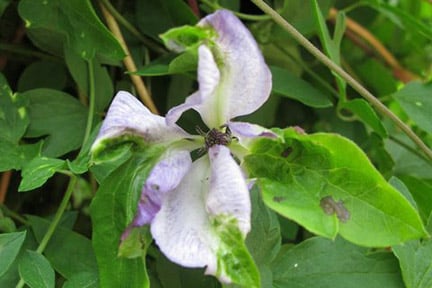
Quick facts
Common name - Clematis green petal
Plants affected - Clematis, especially white- or pale-flowered clematis
Main causes - Especially, low temperatures at the time flower buds are initiated
Timing - Spring
What is green petal?
Clematis green petal is a transient disorder related to cold temperatures. The flowers are perfectly formed, unlike those affected by green flower disease, where blooms may be distorted and remain green throughout the growing season. Green flower disease is permanent and incurable.
Appearance
On opening, clematis flowers show varying amounts of green – from a tinge of green along the centre line of the (petal) to the entire bloom failing to colour. They are not distorted in any way.
If flowers are distorted, and they continue to bloom all season with the same symptoms, green flower disease may be responsible.
Causes
Several thing may give rise to green petal;
- The causes are thought to be low temperatures at a critical stage in the development of the flowers. If there has been an unusually cold period in spring, green petals often follow a few weeks afterwards. The flowers following these are perfectly formed
- Pale or white-flowered cultivars, such as C. ‘Nelly Moser’ and C. ‘Duchess of Edinburgh’, are particularly affected. Clematis planted in north-facing positions also tend to be susceptible
- If the blooms are continuously green and distorted throughout the season, a bacteria-like organism called mycoplasma may be to blame. This is known as green flower disease
Control
The need for control depends on the cause and persistence of the problem;
- If the subsequent flowers are formed normally, there is no need to control
- If unusually cold weather is forecast, protect plants with horticultural or a similar material
- If the flowers continue to be green and distorted even once temperatures improve, then the plant may well have a phytoplasma (a micro-organism that is not treatable) infection and should be destroyed, as there is no control available. If the plant is left, there is a risk that the infection could be transferred to other clematis plants in the garden







